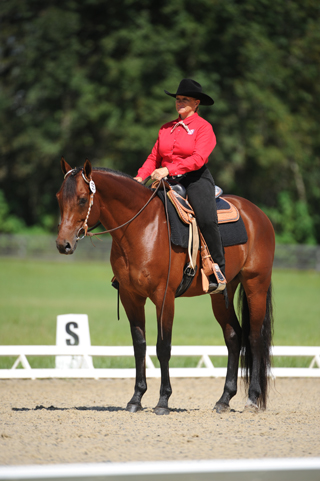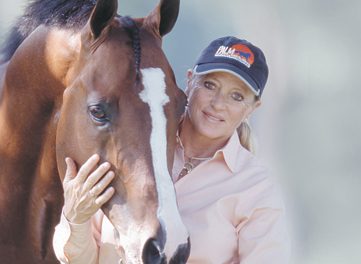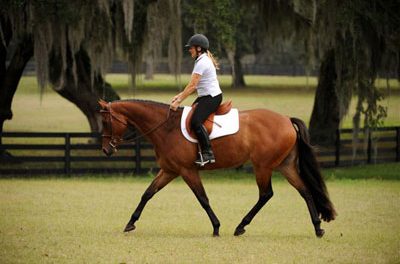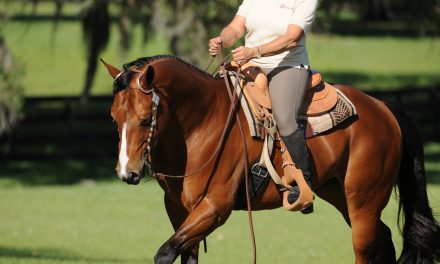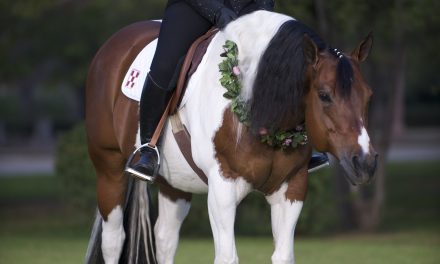Building A Partnership With Your Horse
 In this article, we continue our series on “training outside the box.” In our last article we introduced some simple stretching and flexibility exercises to prepare for riding outside confined areas, such as arenas and paddocks.
In this article, we continue our series on “training outside the box.” In our last article we introduced some simple stretching and flexibility exercises to prepare for riding outside confined areas, such as arenas and paddocks.
To do these exercises you will need a consistent, well schooled horse that is tacked up with saddle, bridle and leg protection. Practice in a large enclosed area like a paddock, corral, or arena to give you and your horse more security. These exercises can be done in either a Western or English saddle. A Western saddle will give you more security, and it is a great confidence builder. However, whether you are a Western or English rider, using an English saddle for these exercises will help to build better form, balance, and confidence.
As with all physical activities, if you experience any pain or have medical conditions that could be complicated by doing any of these exercises, STOP! Seek advice from a health care professional before continuing.
All of these exercises should be done very slowly. Be sure to breathe when doing them. This is important because it encourages relaxation. If you find yourself holding your breath, talk or sing to encourage regular breathing.
While doing these exercises think “CENTER-SQUARE-BALANCED.” Continually analyze your position using these three key words to maintain proper rider position while working to improve your flexibility.
More Lower Body Exercises/Stretches
Knee to Elbow Touches:
Sit centered in the saddle with your legs in normal riding position and feet out of the stirrups. Bring both arms in front of you. Keeping your elbows close to shoulder height, bend them in a 90-degree angle. Your arms should look as if you are getting ready to do a chin up from an imaginary bar located in front of your face.
Starting with the left leg, bring the knee up until your leg touches the elbow. Then bring the leg back down. If you have difficulty doing this, bring your shoulders back slightly, which will allow more mobility in your pelvis area. Try not to collapse your upper body to bring the elbow to the knee, but instead use your leg muscles to bring the knee to the elbow. Do 3-5 of touches on one side, then switch. Gradually build yourself up to doing more.
Leg Swings:
Take your feet out of the stirrups and hold onto the saddle’s pommel to help keep your body centered during this exercise. Working one leg at a time, slowly swing the entire leg forward as far as you can, and then extend it backward as far as possible. Keep the knee slightly bent. To be effective, the movement must come from the hip joint not from swinging the lower leg from the knee. Keep your upper body as centered and still as possible. Do several swings with one leg, and then switch to the other leg.
Thigh Openers:
This is a more difficult exercise that really helps to stretch and open the inner thigh while improving balance. Starting with the left leg, bring the knee up in front of the saddle. Grasp the front of the knee with the left hand. Keeping the knee up and level, flex the leg from the forward position, and then press it outward to the side as far as possible. Your hand should guide your leg, not hold it up! Be careful not to pull the leg so hard outwards that you overstretch the inner thigh muscles. Slowly move the leg forward, outward, and then back to forward. The upper legs should stay very level, and the lower leg is off the saddle.
Still More Lower Body Exercises/Stretches
The purpose of the following exercises is to build lower leg and ankle flexibility. They can be performed at the walk, trot, and some at the canter. For these exercises, the reins should be organized and in one hand. Do not tie them around the saddle horn.
Upper Thigh and Ankle Flex:
This exercise can be done standing still or at the walk. Start with the right leg. Taking the right foot out of the stirrup, flex the knee and bring the foot up and behind you to the back of the saddle’s cantle. Grasp the back of the ankle with your right hand as you keep the foot flexed. Hold this stretch for five to ten seconds and breathe! Keep the knee on the saddle and stretch the upper leg down. Then release the ankle and allow the lower leg to stretch back down toward the stirrup. Do the same with the other leg. This is a great exercise for stretching the thigh muscles and improving ankle flexibility.
Ankle Circles:
Riding without stirrups is always a good way to improve flexibility and balance. With the horse at the walk or trot, rotate both ankles in a circular motion inward toward the horse. Repeat, but rotate outward. Do several sets of rotations.
Toe Points:
Again, riding without stirrups with the horse at the walk or trot, flex the ankles so that the toes point upwards. Hold for a few seconds. Then flex the ankles so that the toes point toward the ground. Add some variety by practicing picking up your stirrups by just flexing the ankles inward without letting the lower leg move. Drop your fee from the stirrups and start again.
Mix and Match:
Be creative as you do all of the exercises I have given you. Mix and match them to develop your own personal warm-up and flexibility routine. Try placing one pole on the ground where you will be working. Practice doing one or several exercises as your horse walks or trots over the pole.
Pick Up the Pace—Exercises at the Canter:
Once you feel secure doing the upper body exercises I explained in a prior article, try doing them at the canter. Mix and match to incorporate them into a smooth pattern. This would include head and neck stretches, one-arm backstrokes, shoulder shrugs, and arm-to-the-side. Doing these exercises will help you follow the motion of the horse as you either trot or canter over the pole. Now drop your stirrups and repeat the upper body series at the canter.
Multiple Poles—On a Straight Line:
Using several poles challenges you to stay centered, balanced, and relaxed. Start with two poles on the ground. They should be a minimum of 3-1/2 feet apart. This will give you some adjustment time to get your balance after going over the first pole and before reaching the second pole. With your feet in the stirrups, pick up a trot. Go over the first pole, adjust your balance, and continue over the next pole. Concentrate on keeping the shoulders back and the hips moving forward. Keep looking up and out and not down!
Once you feel centered, balanced, and relaxed going over two poles, add a few more, keeping them at the same distance apart. More poles add to the challenge because you will constantly need to adjust your position as the horse increases his movement to trot over them. Do a set with your stirrups, and the next one without stirrups. Keep breathing to stay relaxed. If you have difficulty, take one pole away. If you do well, add more poles.
Multiple Poles—On a Curve:
Once you have mastered the poles in a straight line, place the pole on a curve for a more advanced exercise. Staying balanced and in position on a turn adds to the degree of difficulty. The horse and rider will have the natural tendency to pull to the outside. The rider must stay centered, square, and move the hips to stay balanced.
Arrange two or three poles on a curve. The poles should be placed so that they radiate like spokes along the perimeter of a curve. The rider should try to go over the middle of the poles. Go over the poles at the trot, first with and then without stirrups. Then try doing some of the upper body exercises as you trot over them.
In the next article, we will learn some exercises to do on the longe line. For even more exercises that will help you improve your position and balance, please check out my book Head to Toe Horsemanship. To order this or other instructional materials, please visit the website at www.lynnpalm.com or call 800-503-2824.

